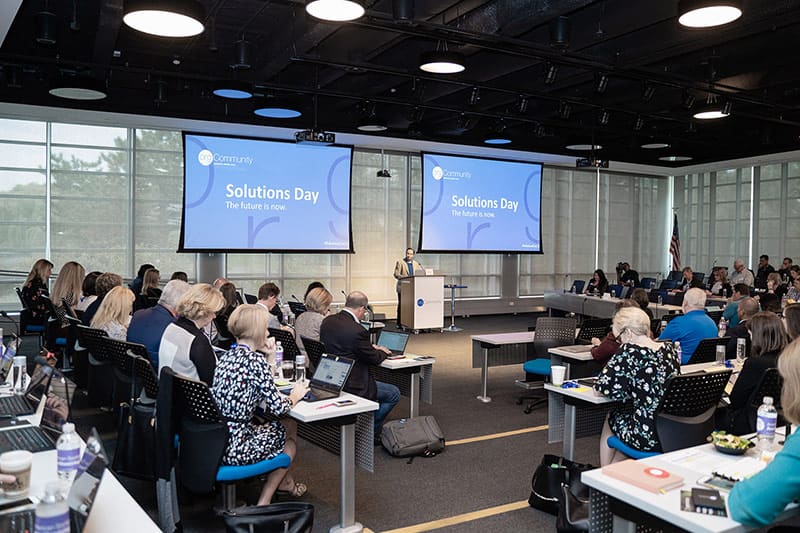You installed a new LMS, CMS and AMS; redesigned the website; migrated to the cloud; and purchased the latest computers, printers and tablets for your staff. Was it a digital transformation? Sorry, you’re only about halfway there—maybe not even. You’ve got the technology covered. It’s the transformation process that’s trickier to understand.
Googling digital transformation might only add to your confusion. The definitions are both vague and sweeping. Most include a disclaimer that the process will unfold differently from one organization to another. Here’s a sample of the language from Wikipedia:
Digital Transformation (DX) is the novel use of digital technology to solve traditional problems. These digital solutions enable inherently new types of innovation and creativity, rather than simply enhance and support traditional methods.
From my perspective, digital transformation refers to how we use technology, not what technology we are using. It means applying the power of electronics to optimize governance, operations, administration and member services in entirely new ways. Although it might sound like technology is the driver, people are the real power behind this phenomenon.
Think Like an Entrepreneur

You and your team are the agents of change. Unless you are willing to embrace risk, innovation, experimentation and new patterns of thinking there can be no transformation. If that sounds more like it’s a good approach for start-ups, that’s because it is. The future is going to demand that successful organizations stop doing business as usual and adopt the tactics that entrepreneurs use to keep their enterprises viable.
Why should associations, groups with a history of revering tradition and gravitating toward stable platforms and predictable outcomes, try to reinvent themselves? I believe that they don’t have a choice. “Winter is coming.” Whether you’re a Game of Thrones fan or not, that warning says it all. The business environment is changing. If you’re not prepared, it will be harsh. Anticipation, preparation and a strategy to maximize digital capability will be essential to compete.
The frustrating paradox of technology is that it makes life both easier and simultaneously infinitely more complex. The capability to deliver personalized, on-demand products, education and experiences of all kinds is expanding exponentially. Riding this trend is at the heart of digital transformation. Amazon and other masters of the tech universe are conditioning consumers to expect the seamless interactions that apps, AI and a growing arsenal of modern miracles brings.
If you are an executive who is already exploring your association’s ability to navigate the digital era—congratulations! If you are wondering whether your organization is ready to succeed in this new environment, these are symptoms that should alert you to critical deficits:
External
- Membership attrition without new growth
- Declining participation in association events
- Low traffic on the website and social platforms
- Complaints about user experience
- Competitors vying for your members’ attention
Internal
- Inability to clearly identify member demographics and create market segmentation
- Lack of evidence that you are delivering member value and understanding your members’ needs
- Uncertainty about staffing and talent
- Administrative processes that are inefficient, siloed or too expensive
- Ongoing discussion about these challenges
Evaluate Your Digital Maturity

Even if your organization is enjoying peak performance, you can’t afford to remain an island in the sea of change. This is not just a business trend limited to the largest companies, digital transformation is a social and cultural movement.
To directly experience the impact of online commerce, drive to your local shopping mall and count the retail businesses that have closed over the last year or two. Whether you are currently successful or struggling, evaluating your association’s approach in each of the following areas will help you determine your level of maturity on the digital continuum:
Customer Satisfaction
Association mission statements typically focus on improving the status of the profession. I think we sometimes lose sight of the members in service of advancing those priorities. Digitally savvy companies have abandoned thinking of their customers as a group and embraced understanding them as individuals. They are using analytics on social media and in their various databases to identify demographics, segment audiences and play to preferences in significant and impactful ways. Maximizing technology to give customers easy and engaging experiences with the brand is also a top priority. Users expect an intuitive online platform. Too many clicks between visitors and what they are searching for is increasingly unacceptable. Some examples of customer friendly uses for technology are:
- Chatbots to answer common questions
- AI to distinguish preferences
- Data analytics to assess progress
Operational Efficiency
This laser focus on service isn’t possible with operational distractions such as:
- Inadequate reporting capabilities or other problems related to data analysis
- Siloed departments that make it impossible to understand your members as complete personas
- Insufficient human resources to get all the work done
It’s unlikely that an organization entangled in a net of administrative problems, can rise to new expectations for customer care. Remote work, freelancers and collaborative office configurations aren’t just trendy ways to attract Millennial employees, they are strategies that allow for a more nimble and focused approach to business. Optimal use of technology to facilitate communication among audiences is another rung up the ladder to digital sophistication.
Business Strategy
Adjusting business models to deliver on member engagement is both the first and the last challenge of digital transformation. Adopting an entrepreneurial attitude is critical. Leaders must be ready to discard ineffective programs and policies, explore and test new possibilities and implement change. This is not a one-time exercise that occurs as a result of strategic planning. It is a continuous activity that becomes part of the organizational culture. There must be room to tolerate risk, a space where innovation can grow and financial resources dedicated to ongoing experimentation.
Build a Culture for Change
Success across these three dimensions requires a significant shift in attitude for associations. CEO’s carry the primary responsibility for achieving that change. They must be strong leaders who can convince their constituents and staff that the challenges involved are worth the effort. They should model the qualities that they seek from others, such as openness, flexibility and a desire to improve. More importantly, they will need what every entrepreneur taps into when times get tough—a passion for the journey and the conviction that there is always a better way.


